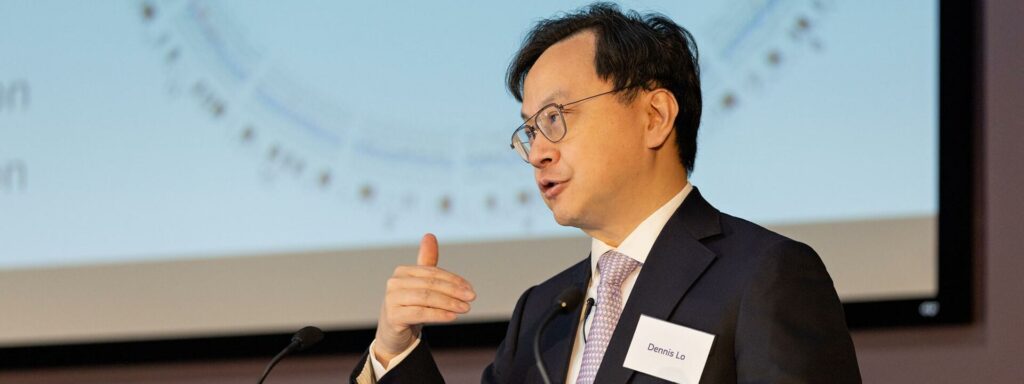Widely regarded as a founder of cell free DNA (cfDNA) technology, Professor Dennis Lo is now pioneering investigation into the emerging science of fragmentomics. If you were at were at our recent policy summit: making science work for health – from genomic foundations to policy futures you will have heard Prof Lo eloquently and often amusingly, shed light on this exciting discovery emerging in the field of cfDNA.
Where does a cell-free DNA fragment come from?
Cells die, mainly as part of routine biochemical processes or sometimes due to disease. When a cell dies it releases nucleic acids – including DNA – into the bloodstream. This happens with all cells including tumours. The cell free DNA fragments from tumours carry genetic differences compared to normal tissues. Analysing these differences is providing information which ultimately can be used to improve diagnostics and treatment planning in multiple diseases.
Less invasive testing
The use of cfDNA to support cancer diagnosis has rapidly gained traction in healthcare, due to the method reducing requirements for invasive tests, such as tumour biopsies. Cell free DNA analysis is also used during pregnancy, to provide a less invasive initial foetal DNA screening options in certain high-risk pregnancies. In pregnancy, analysis focuses on the difference between maternal and foetal DNA. It has also been found to differentiate between women with and without preeclampsia suggesting potential values as a biomarker in pregnancy associated disorders.
Building on their work on cfDNA and Epstein Barr virus DNA screening in people at risk of nasopharyngeal carcinoma Lo and colleagues have been investigating the potential of non-genetic markers to further enhance cell free DNA testing.
What other non-genetic methods are being investigated?
One such marker is the methylation pattern of a tissue. Methylation is a biochemical change to DNA that doesn’t alter the genetic sequence but impacts how a DNA strand is read. The patterns of methylation vary between different tissue types – low methylation (hypomethylation) is a widespread feature of many cancer genomes. These differences are useful to know, because it is difficult to locate where in the body a detected cfDNA fragment comes from. Methylation pattern analysis provides a birds-eye view of an individual’s plasma ‘methylome,’ theoretically creating a map for identifying cancers and their location in the body. Methylation is key to Lo et al’s work on fragmentomics.
Fragment size matters
Another technique that analyses non-genetic markers of cfDNA and groups them into different types – or profiles – is called fragmentomics. Fragmentomics involves looking at markers such as the size of the cfDNA fragment, and the pattern of DNA bases at the ends of the fragments. Cell free DNA fragment profiles can be used to differentiate between foetal and maternal circulating DNA, cancerous and non-cancerous tissue and to determine tissue of origin. This technique allows multiple investigative tests to be performed with a single sample, reducing the time spent on invasive patient procedures and time to treatment
Professor Lo and team are taking this type of analysis one step further.
Fragmentation of DNA is non-random and variable depending on the methylation status of a molecule. Lo and his team have used these features to develop a method for determining methylation status of cfDNA using fragmentomics – FRAGmentomics-based methylation analysis (FRAGMA).
Lo’s team have developed FRAGMA based profiles which consider the fragmentomics and the methylation pattern of cfDNA. Work in the laboratory shows that these FRAGMA based cfDNA profiles can determine the contribution of different tissues to the plasma DNA found in the blood stream. In both mice liver transplant and pregnancy models, researchers were able to identify tissue specific profiles determined by hyper- and hypomethylation patterns.
One critical question they are asking is “can fragmentomics differentiate between cancerous and non-cancerous tissue?” The methylation pattern of cfDNA is very specific to the cancer it originates from. By exploiting the abundance of plasma DNA hypomethylation in hepatocellular carcinoma cancer (HCC) patients the team demonstrated that cfDNA extracted from HCC patient plasma has patterns very specific to the cancer. Furthermore, a decrease in HCC specific patterns coincided with changes in the amount of cfDNA seen from the tumour, which depends on the tumour stage i.e., how advanced it is and how large it has grown. This suggests the potential to use a single sample further for tumour staging.
Seeing more with long reads
Finally, the near exponential advance in sequencing technologies now allows sequencing of longer DNA fragments, providing a wealth of previously uncharted information. As beautifully described by Lo, long read sequencing is akin to switching from typing 140-character messages to using a whole document to convey information. Long read sequencing combined with complex machine learning algorithms also has the potential to visualise DNA methylation profiles more accurately. This provides not only the opportunity to examine the DNA for genetic information but also for epigenetic data (such as methylation) that would enhance the function of a single sample and its downstream applications. During the analysis of LRS cfDNA isolated during pregnancy Lo and his team have demonstrated the ability to differentiate tissue of origin. This holds potential to deduce foetal maternal inheritance, in turn leading to new options for non-invasive prenatal testing of monogenic diseases. Additionally, cfDNA size and end patterns differed between preeclampsia and non-preeclampsia samples, opening the door for further exploration of markers for pregnancy disorders.
Fewer tests, more information
These small-scale proof of concept studies highlight the potential use of FRAGMA to enhance the utility of diagnostic procedures. The combination of multiple diagnostic procedures into a single test holds immense potential in improving patient experience, time to treatment and overall cost by circumventing multiple invasive procedures. Professor Lo’s work also shows that the procedures are agnostic of cancer type or tumour stage, enabling application across multiple pathologies. While these investigations still require large scale validation and further exploration within other disease processes, there is no doubt that Professor Lo and his colleagues are already moving forward to harness the power of cfDNA and fragmentomics.

